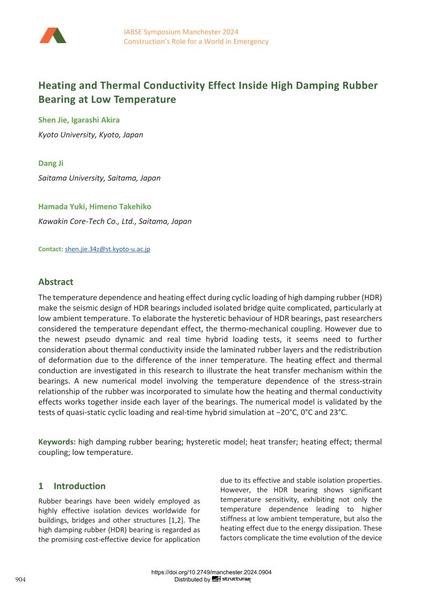Heating and Thermal Conductivity Effect Inside High Damping Rubber Bearing at Low Temperature

|
|
|||||||||||
Bibliographic Details
| Author(s): |
Shen Jie
(Kyoto University, Kyoto, Japan)
Igarashi Akira (Kyoto University, Kyoto, Japan) Dang Ji (Saitama University, Saitama, Japan) Hamada Yuki (Kawakin Core-Tech Co., Ltd., Saitama, Japan) Himeno Takehiko (Kawakin Core-Tech Co., Ltd., Saitama, Japan) |
||||
|---|---|---|---|---|---|
| Medium: | conference paper | ||||
| Language(s): | English | ||||
| Conference: | IABSE Symposium: Construction’s Role for a World in Emergency, Manchester, United Kingdom, 10-14 April 2024 | ||||
| Published in: | IABSE Symposium Manchester 2024 | ||||
|
|||||
| Page(s): | 904-912 | ||||
| Total no. of pages: | 9 | ||||
| DOI: | 10.2749/manchester.2024.0904 | ||||
| Abstract: |
The temperature dependence and heating effect during cyclic loading of high damping rubber (HDR) make the seismic design of HDR bearings included isolated bridge quite complicated, particularly at low ambient temperature. To elaborate the hysteretic behaviour of HDR bearings, past researchers considered the temperature dependant effect, the thermo-mechanical coupling. However due to the newest pseudo dynamic and real time hybrid loading tests, it seems need to further consideration about thermal conductivity inside the laminated rubber layers and the redistribution of deformation due to the difference of the inner temperature. The heating effect and thermal conduction are investigated in this research to illustrate the heat transfer mechanism within the bearings. A new numerical model involving the temperature dependence of the stress-strain relationship of the rubber was incorporated to simulate how the heating and thermal conductivity effects works together inside each layer of the bearings. The numerical model is validated by the tests of quasi-static cyclic loading and real-time hybrid simulation at −20°C, 0°C and 23°C. |
||||
| Keywords: |
heat transfer low temperature high damping rubber bearing hysteretic model heating effect thermal coupling
|
||||
